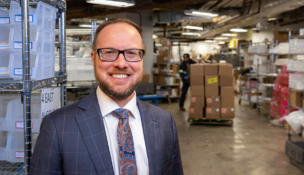Vying for dollars
Virginia health systems compete for federal grants aimed at improving care
Robert Burke //October 30, 2013//
Vying for dollars
Virginia health systems compete for federal grants aimed at improving care
Robert Burke //October 30, 2013//
Some of Virginia’s biggest health systems are competing for a share of a big pot of money designed to improve health care and cut costs.
The $1 billion Health Care Innovation Awards, a product of the 2010 Affordable Care Act, will be distributed in January by the Centers for Medicare and Medicaid Services. The competition is tough: The first round of the program last year attracted nearly 3,000 applications, but just 107 received funding. Virginia had applications from 79 organizations, and just four were successful. “In general we did not do very well,” says Beth Bortz, president and CEO of the Richmond-based Virginia Center for Health Innovation (VCHI).
This year, Bortz’s group worked to help four major health systems in Virginia improve their chances. Any organization can apply on its own, and many will. But Bortz’s group got involved in working with the health systems because, based on how the first round of funding was distributed, it seemed that they had the best chance. “We wanted to see if we could bring some of the key partners around the table so we could develop a multi-stakeholder approach,” she says.
There wasn’t much time; the second round of grant applications opened in May and ended in August. Virginia’s Secretary of Health and Human Resources Bill Hazel, who is chairman of the VCHI board, nudged applicants to work with Bortz’s group by steering them to VCHI for help in gathering data related to Virginia’s Medicaid program. “So that at least got people to the table initially,” Bortz says.
Though the proposals target different patient groups, “they all seemed to have a similar approach,” Bortz says. They are aimed at creating medical communities that bring together a range of health-care providers to support patients who struggle to deal with multiple medical conditions and difficult social circumstances. The proposals involve identifying “the folks that are going to be the very expensive patients, and how do they get them into their system, and how to design a payment model that does a better job and … properly [encourages] the providers of this care,” Bortz says.
The proposals
Here’s what the health systems proposed in their grant applications:
University of Virginia Health System: U.Va. proposes to target two groups — children with chronic conditions and multiple medical issues, and adults with dementia. Both groups share a common predicament: They depend on “informal caregivers who under the best of circumstances cannot carry this burden alone,” according to a summary of the proposal. U.Va.’s proposed program, called By Your Side, would put much of its focus on helping the people who act as caregivers. The grant proposal is seeking a total of $2.7 million over three years.
“Both sets of these patients are complicated, and the nuances of caring for them are really critical, and the people who know those nuances are taking care of them every day,” says Dr. Margaret Plews-Ogan, associate professor of medicine and head of the division of general medicine and geriatric medicine at U.Va.
These two populations are increasing, as is the cost of their care. The Alzheimer’s Association projects that 16 million Americans will have Alzheimer’s by 2050, up from 5.2 million people this year. The cost of care is expected to increase from $203 billion this year to $1.2 trillion during the same period. Those costs could be reduced if the caregivers are given support in the often-complicated task of coordinating care. “Mobilizing and sustaining these caregivers with the right care in the right place at the right time is the goal of the By Your Side prevention and intervention program,” says U.Va.’s proposal.
Part of the grant would be used to educate caregivers, and another part would help them connect with one another through Web-based By Your Side programs. The U.Va. proposal predicts its program can produce a total savings of $2.74 million over three years. “Unfortunately our [current] health-care system doesn’t reach very well into the home,” Plews-Ogan says. “And it certainly hasn’t necessarily learned how to interact best with what is a true extension of our health system, which is the caregiver in the home.”
Virginia Commonwealth University Health System: VCU submitted two proposals. One is for a $6.9 million program focused on patients under 18 years old in the Greater Richmond region. These are patients with multiple medical illnesses as well as behavioral issues and a fragile home environment. The program is dubbed M-PACCT, for Mobilizing the Pediatric Ambulatory Complex Care Team. The idea is to coordinate care provided by multiple doctors and other health-care providers while bringing the patient’s family’s needs into the mix as well.
“What we’re doing is thinking about the whole child and the family,” says Sheryl Garland, vice president for health policy and community relations for the VCU Health System. Oftentimes a patient’s care can be interrupted because the adult responsible for managing it can’t keep up. “Our idea was … how can we make it easy so that the family knows what’s going to happen, and when does the child need to be where? It’s coordinating those types of things that can really make it difficult for families.” The proposal includes a partnership with the Family Lifeline/CHIP of Greater Richmond, which provides home-based services.
The second and larger VCU proposal is for $17.6 million for a program that would target patients who use a lot of health-care services. These are patients who are on Medicaid or Medicare or are uninsured and have a number of chronic conditions, including behavioral health problems.
VCU wants to create a program called ACCIST (Ambulatory Care Coordination Interdisciplinary Support Teams). It would work with up to 3,000 people in the Richmond region and put together teams of health-care providers — such as nurse case managers, psychologists, pharmacists and social workers — to try to give patients better care and reduce unnecessary use of health-care services. VCU would work with the Washington, D.C.-based Institute for Public Health Innovation, which has created community health worker models in Virginia and Maryland.
The money would be spent in part on hiring staff and creating an integrated information system so that a patient’s medical history and information on current care could be accessed by various providers. There also would be financial incentives to reward efforts that improve care and reduce costs.
Bon Secours Virginia Health System: Richmond-based Bon Secours is working with the United Methodist Family Services (UMFS) in seeking a $5.5 million grant over three years to develop its Integrated Health Care Model. The idea is to merge the expertise of UMFS in adolescent behavioral health and family services with Bon Secours’ medical resources. “So it makes it easy for them … So the teenage mother of three who is pregnant again and coming in for a prenatal screening at one of our practices can walk across the hall and work with a social worker who is going to teach her about birth control or nutrition,” says Robert Fortini, vice president and chief clinical officer for Bon Secours Virginia.
“What we want to do is get the collaborative, integrated model up and running in seven locations” in urban sites in the Richmond region and in rural parts of western Virginia, Fortini says. “With the Affordable Care Act, medical home-type reform in care delivery is a real hot topic,” he says. “How do you change from a fee-for-service environment where physician incomes are based on how many patients they see per day” to paying them for improving the patient’s health. “That’s a very difficult thing to do for a lot of complicated reasons.”
Carilion Clinic: The focus for Roanoke-based Carilion is on children who face complex medical conditions and need help with behavioral issues and with their social environment. Carilion seeks a three-year, $5.5 million grant and has some specific goals, such as a 50 percent reduction in asthma-related hospitalizations and in emergency department visits.
The program will be set up at two pediatric practices. It will involve hiring a “health concierge” who will help screen children to determine what they need and assist their families in connecting with the community resources available to them. The grant money would also pay for hiring in-home care managers for asthma, prenatal care and behavioral health. “It’s very intensive, but in the home and community setting,” says Dr. Colleen Kraft, a pediatrician and program director for pediatric residency at Carilion.
Kraft says pediatric care has seen major change since she started practicing in 1989 when there were two groups — sick kids and well kids. Today, vaccines prevent a lot of the infectious diseases that once were common. “What we’re seeing now is obesity, asthma, autism, behavioral health” issues, she says. These are conditions that can’t be treated during a brief office visit. “You can’t do a lot about obesity in your office,” she says. “It’s really about getting into the home.”
Much of the focus is on prevention, which includes assisting parents — coaching them about good parenting practices and even directing them to resources for getting their GEDs or finding jobs, she says. All of those things factor into what kind of care a chronically ill child will receive. “You’re treating all of the environmental factors that influence that condition,” she says.
Other applicants
Dozens of other organizations in Virginia may have applied for grants, but it’s hard to say how many because the Center for Medicare and Medicaid Services is not releasing details about the number of applicants in each state.
Bortz also has her eye on another pot of federal dollars, which is intended to help states implement a multiyear health innovation plan. Virginia is working on such a plan, but whether the state applies for the money likely will be a decision made by Virginia’s next governor.
States can seek up to $60 million for the implementation “and $60 million is not chump change,” Bortz says. “We will have this plan all ready to submit, and we just have to hope” the next governor will be willing to do so. “It’s very important that we have a shot to go after those funds, because quite frankly, if we’re allowed to apply, Virginia has a very good chance of winning.”
l
















